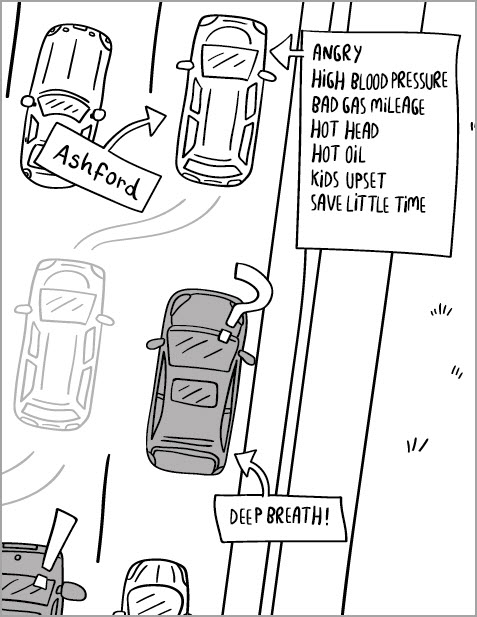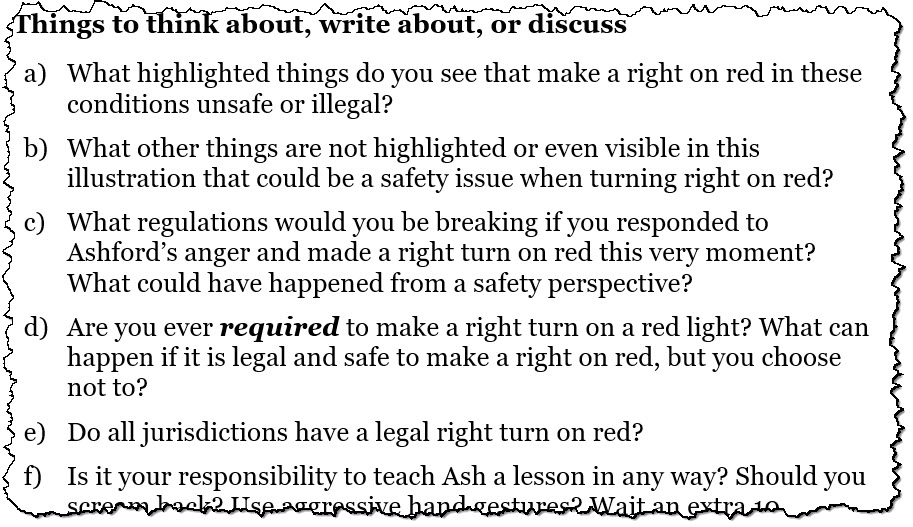Providing memorable and effective driver education, particularly when addressing issues such as aggressive, distracted, and impaired driving, requires a range of teaching methods and content approaches to best engage students and help them retain the information.
Whether you’re teaching a teen their first driver ed class, helping an adult refresh their skills, or guiding a family member to develop safer habits, the key to learning and retention is engaging as many learning styles as possible. This isn’t just a theory; it’s a proven educational approach that boosts engagement, retention, and real-world application.

In this blog, we’ll examine three powerful strategies for classroom materials that support learning:
- Clear, relatable visuals
- Humor that makes students smile and laugh
- Discussion prompts that challenge students to think and generalize.
Each of these elements appeals to different learning styles and cognitive processes, making lessons more memorable and effective. This is especially important when trying to shape and change aggressive and risky behaviors behind the wheel.
Note: This blog doesn’t cover behind-the-wheel instruction or other effective methods like using manipulatives to demonstrate theories, such as real-world exercises to illustrate reaction time.
Why Content Reflecting Multiple Learning Styles Matters in Driver Education
People absorb and remember information in different ways. Some learn best by seeing, others by hearing, and most by doing. Research consistently shows that relying on just one teaching method leaves most learners behind, while a multi-modal approach that incorporates visuals, stories, humor, and dialogue results in better understanding and longer retention. Your content should support as many modes as possible.
This is especially important in driver education, where the stakes are high, and the goal is not just to pass a test but to internalize safe driving behaviors that can save lives. Let’s look at three proven approaches to classroom content through these three lenses.
1. Clear, Relatable Visuals: Making the Abstract Concrete
Visuals are much more than decoration. Visuals are among the most powerful tools for making learning stick. Studies show that learners retain up to 65% of information when visuals are used, compared to just 10% from listening to a lecture and 20% from reading text. Visuals with a number of storytelling approaches clarify complex or abstract concepts like stopping distance, reaction time, or the dangers of tailgating by making them concrete and relatable.
Why visuals work:
- The brain processes visuals 60,000 times faster than text.
- Dual-coding theory states that when information is presented visually and verbally, it is processed more effectively and remembered longer.
- Visuals can enhance learning by as much as 400% compared to text alone.
- Comics, memes, and graphic novels are increasingly being used and becoming more commonly used by students of all kinds.
Imagine telling students that texting and driving is dangerous. Now, compare that with a relatable illustration (funny, to boot!) of someone they know doing three things at once behind the wheel, shown just seconds before a collision. Students are much more likely to remember—and apply—this information when they can visualize it in relatable, real-world terms.
Use annotated diagrams, infographics, dense visuals, and illustrations that connect with personal stories, not just block diagrams. Ensure visuals are directly relevant to the lesson and relatable to the learner’s experience.
2. Making Students Smile and Laugh: The Power of Humor
Humor isn’t just for entertainment, it’s a powerful teaching tool. When used correctly, humor boosts attention, engagement, and memory. Studies show that information presented with humor is remembered better than a straightforward delivery.
How humor helps learning:
- Humor triggers the brain’s reward system, releasing dopamine that boosts memory and learning.
- Humorous content boosts attention and engagement, making lessons more memorable.
- Emotionally charged memories, like those linked to laughter, are easier to remember.
- Seeing someone else do something funny and ridiculous makes it easier for people to admit to themselves that maybe they do that too (and maybe they shouldn’t).
- A study found that students who used humor while learning performed significantly better on recall tests than those who learned through traditional lectures.
- Puns, jokes, and limericks, when relevant to the material, help reinforce information and improve recall.
- Another study found that for both intermediate and advanced learners, lessons featuring jokes, puns, and limericks performed better than those using traditional methods, with jokes being the most effective. Still, all forms of humor had a significant positive impact.
In the “Don’t Drive Like This” project, limericks and funny, dense, story-based line drawings illustrate the consequences of aggressive driving with memorable, light-hearted scenarios. Students not only laugh, but also remember what not to do behind the wheel.
A limerick from “The The Besieged Bicyclists“
At the lights, chaos reigns in the air. Ashford curses! Gives cyclists a scare. Ashley shouts at the lane, Ashton’s cycling’s insane. This shared road is chock full of despair.
Include relevant, age-appropriate humor, such as a pun, a cartoon, or a funny story, in your driver education materials and presentations. The key is to make sure the humor is directly related to the learning point and not a distraction.
3. Discussion Prompts: Letting Students Draw Conclusions
Open-ended questions and discussion prompts are crucial for deep learning. They motivate students to think critically, apply lessons to new situations, and remember information more effectively than rote memorization or passive reading.
Benefits of open-ended discussion include:
- Encouraging critical and creative thinking, communication skills, and confidence
- Encouraging learners to relate new information to their own experiences, making it more meaningful and memorable.
- Fostering active participation and peer-to-peer interaction have been connected to developing critical thinking skills, increasing motivation, enhancing communication, and achieving higher grades.
- Creating social opportunities among students, instructors, and family reinforce the importance of the issues at stake.
- Helping learners express themselves, building self-confidence and deeper understanding.
- Jump-starting class discussions that require students to apply knowledge to new scenarios help them generalize learning and retain it longer.
Instead of telling students, “Don’t tailgate,” ask, “What could happen if someone tailgates in heavy rain?” or “Tell a story about a time when you felt pressured by another driver, and how you responded?” These prompts encourage students to reflect, share, and internalize the lesson through their own experiences.

Use open-ended questions and real-life scenarios in both classroom and family settings. Challenge students to apply what they’ve learned to new situations, and let them discuss and debate possible outcomes. This not only reinforces learning, but also helps them develop the judgment needed to make safer decisions on the road.
4. Generalizing Learning: Discussion Prompts Foster Applying Lessons to New Situations
The test of effective instructional materials is whether students can apply what they’ve learned in new and unpredictable situations. Discussion prompts and active conversation are crucial for this skill. Why?
- When students are prompted to generalize and apply lessons, their ability to transfer knowledge to new contexts improves dramatically.
- Active discussion and scenario-based prompts help learners of all ages move beyond memorization to real-world application, which is essential for safe driving.
For example, after discussing the dangers of a different type of road rage, challenge students: “How would you handle a situation where another driver is aggressively honking and tailgating you?” Facilitating a group discussion or role-play allows students to explore different responses and internalize best practices
Be sure the materials you use in Driver Education support different learning styles
Driver education is about more than facts and rules. To truly reduce aggressive driving and road rage, instruction must engage multiple learning styles, visual, auditory, social, and kinesthetic. By anchoring lessons with materials that use dense, story-based visuals, relevant humor, and open-ended discussion, educators and families can create memorable, meaningful classroom and social learning experiences that stick.
These approaches aren’t just “nice to have.” They’re essential. They help learners of all ages and backgrounds internalize safe driving behaviors, make better decisions while driving, and ultimately contribute to safer roads for everyone.
So, whether you’re designing a curriculum, leading a classroom, or teaching a loved one, remember: the most effective driver education is the one that accounts for multile learning styles.
Select reading and articles used for this blog, and to learn more about this topic
- How Visuals Help Student Retention https://schoolposterprinters.com/how-visuals-help-student-retention/
- How Visual Learning Improves Comprehension and Retention https://www.panomio.com/blog/how-visual-learning-improves-comprehension-and-retention
- Using visuals improves learning by up to 400% – study https://www.theeducatoronline.com/k12/news/using-visuals-improves-learning-by-up-to-400–study/280453
- 65% of People Prefer Visual Learning, Is Teaching Keeping Up? https://blog.videoscribe.co/65-of-people-prefer-visual-learning-is-teaching-keeping-up
- The Effects of Humor on Memory Retention https://www.saidhasyim.com/post/peak-brain-plasticity/the-effects-of-humor-on-memory-retention/
- A Comparative Study of The Effect of Humor Strategies on Iranian EFL Learners’ Vocabulary Learning https://files.eric.ed.gov/fulltext/EJ1330191.pdf
- The Power of Open-Ended Questions https://mcm.org/the-power-of-open-ended-questions/
- Learning Through Discussion https://ctl.columbia.edu/resources-and-technology/resources/learning-through-discussion/
- Referencing Funny: Strategies for Retention with Humor & Education https://www.aath.org/post/referencing-funny-strategies-for-retention-with-humor-education
- How do you facilitate open-ended discussions in class? (Reddit discussion) https://www.reddit.com/r/teaching/comments/1jd9jrh/how_do_you_facilitate_openended_discussions_in/
Leave a Reply